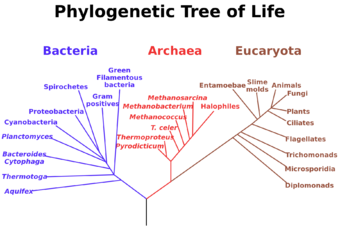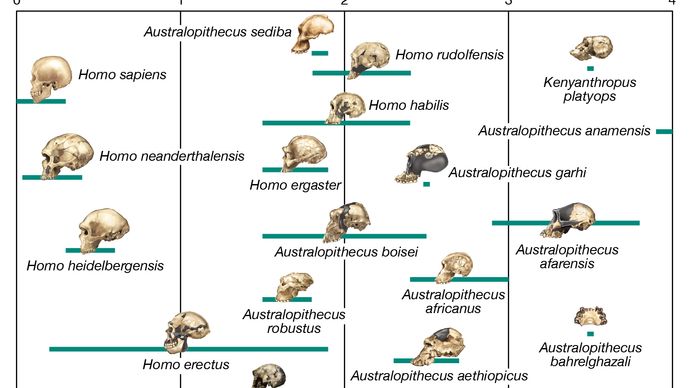Phylogeny Study Guide
Introduction:
Phylogeny is a branch of biology that studies the evolutionary history of all life on earth, particularly in terms of lines of descent and interactions among large groupings of creatures. The phylogenetic hypothesis states that all living species have a common ancestor. Therefore, let’s learn more about phylogeny.
Evidence for specific phylogenies:
- Paleontology, comparative anatomy, comparative embryology, and molecular genetics are among the sciences biologists utilize to hypothesize phylogenies.
- Studies of gene structure and the spatial distribution of flora and fauna are also beneficial.
- The fossil record is frequently employed to define the phylogeny of groups with hard body components and estimate species divergence periods in phylogenies built based on molecular data.
- Most of the information used to make phylogenetic decisions has derived from comparative anatomy and embryology, while methods based on molecular data are fast catching up.
Anatomists strive to discern between homologies or similarities inherited from a common ancestor and analogies or similarities that emerge in response to comparable behaviors and living situations when comparing traits common to various species.
A tentative phylogenetic tree for the human lineage’s evolution. Based on fossil evidence, solid bars represent periods during which species are thought to have existed. Dotted lines represent evolutionary links among hominin species postulated based on fossil data.
Phylogenetic tree:
- A phylogenetic tree is a graphic that shows how creatures have evolved. Phylogenetic trees are, however, only speculations, not certainties.
- A phylogenetic tree branching pattern indicates how species or other groupings emerged from a common ancestor.
- Two species are more linked in trees if they have a recent common ancestor and less correlated if they share a distant common ancestor.
- The nodes on a tree represent the most recent common ancestor of any two groups or lineages.
- Phylogenetic trees can be drawn in a variety of ways. The information carried by a tree does not change as it is rotated around its branch points.
- Phylogenetic trees and cladograms can be constructed from morphological similarities of living or fossil species and DNA and protein sequence similarities.
There are two types of phylogenetic trees: rooted and unrooted.
- A rooted phylogenetic tree suggests that closely related taxa originated from a common ancestor.
- In contrast, an unrooted phylogenetic tree does not indicate a common ancestor and instead speculates on the degree of evolutionary relatedness between species.
The tree diagram is crucial for understanding biodiversity, evolution, genetics, and ecology of distinct creature groupings.
Molecular data typically provide more accurate and reliable evidence than morphological traits in constructing phylogenetic trees or cladograms.
Animal Phylogeny
- A unique phylogeny example is the evolutionary tree of animals demonstrating the history of animal organs.
- It demonstrates animal phylogeny in terms of animal organ evolution.
- The evolutionary connection of major animal lineages may be determined by the organ level of structure in this figure.
- For example, the digestive system appeared some 600 million years ago, while the liver evolved about a hundred million years later in vertebrates like humans.
Phylogenetic analysis in bioinformatics:
- Sequence alignment typically reveals similarities and divergences across related biological sequences, which must be justified and shown in the context of phylogenetic trees.
- As a result, molecular phylogenetics is an important part of bioinformatics. To infer these evolutionary links, molecular phylogenetics utilizes the structure and function of molecules and how they change through time.
- One of the main aims of the evolutionary study is to reconstruct real historical connections between any groupings of species, genes, or proteins.
- Phylogenetic knowledge reveals the pattern of evolutionary relationships, exposing the historical pattern of speciation and divergence and allowing us to classify life according to an evolutionary scheme.
- Furthermore, it is significant because of its numerous uses in biology, including epidemiological research of human illnesses, finding and characterizing newly found pathogens, and locating and tracking natural reservoirs of zoonotic diseases.
Conclusion:
- Phylogeny is a description of the evolutionary history of all life on earth, particularly in terms of lines of descent and interactions among large groupings of creatures.
- A phylogenetic tree is a graphic that shows how creatures have evolved over time. Phylogenetic trees are, however, only speculations, not certainties.
- Molecular phylogenetics is an important part of bioinformatics. To infer these evolutionary links, molecular phylogenetics utilizes the structure and function of molecules and how they change through time.
FAQs:
1. What is phylogeny in biology?
A phylogeny is a hypothesized relationship that is compared between groups of species. A phylogeny is frequently represented by a phylogenetic tree, such as the one below, which depicts the evolutionary relationships between the great apes.
2. What is the study of phylogeny?
The study of evolutionary connections among biological entities – usually species, organisms, or genes – is known as phylogenetics.
3. What is the phylogeny of horses?
The horse, a mammal of the Equidae family, evolved over a geologic time scale of 50 million years, changing the tiny, dog-sized, forest-dwelling Eohippus into the contemporary horse. Much of this development occurred in North America, where horses first appeared 10,000 years ago and then became extinct.
4. Why do biologists care about phylogenies?
Phylogenies allow scientists to compare species and make predictions based on characteristic similarities and differences. A phylogenetic tree may show all living forms’ evolutionary history.
5. What is phylogenetic bioinformatics?
A phylogenetic tree depicts the relationship between species, demonstrating the evolutionary route from a common ancestor to several descendants. As a result, molecular phylogenetics is an important part of bioinformatics.
6. What is a phylogenetic tree in bioinformatics?
A phylogenetic tree, often known as an evolutionary tree, visualizes the evolutionary connections between different organisms. It’s a node-and-branch diagram with nodes and branches. The topology of a tree refers to the branching structure of the tree.
We hope you enjoyed studying this lesson and learned something cool about Phylogeny! Join our Discord community to get any questions you may have answered and to engage with other students just like you! Don’t forget to download our App to experience our fun, VR classrooms – we promise, it makes studying much more fun! 😎
Sources:
- What Is Phylogeny?. https://www.thoughtco.com/what-is-phylogeny-4582303. Accessed 27 Dec, 2021.
- phylogeny. https://www.britannica.com/science/phylogeny. Accessed 27 Dec, 2021.
- Phylogeny. https://www.sciencedirect.com/topics/biochemistry-genetics-and-molecular-biology/phylogeny. Accessed 27 Dec, 2021.
- Phylogeny. https://www.biologyonline.com/dictionary/phylogeny. Accessed 27 Dec, 2021.


